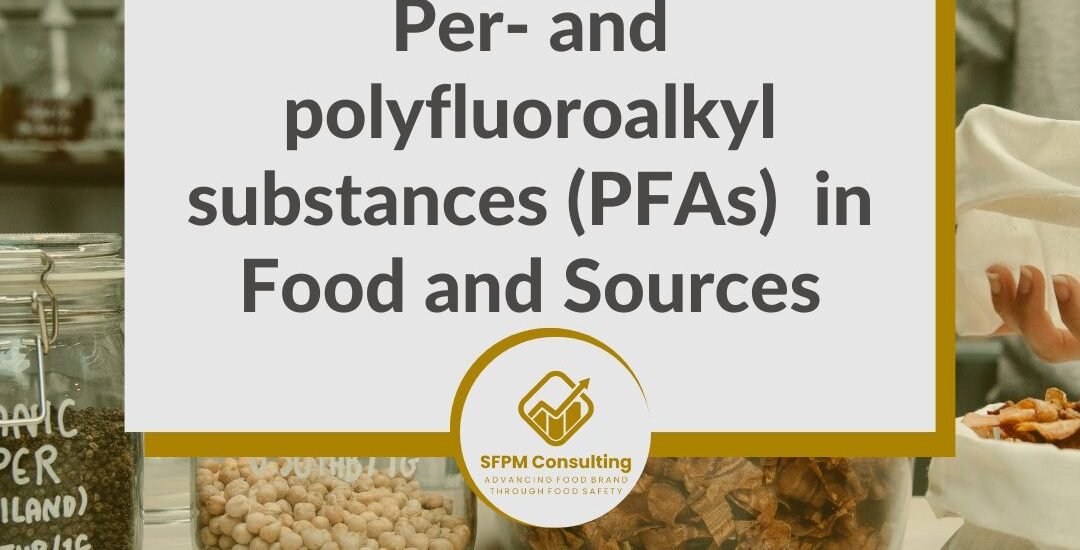PFAs in Food and Sources
- August 27, 2024
- Posted by: Felicia
- Category: Food Safety

Understanding the Presence of PFAs in Food
What is PFAs?
Per- and polyfluoroalkyl substances (PFAs) are a group of synthetic chemicals that have been widely used in various consumer products for decades. Their unique ability to repel water and oil makes them ideal for applications in non-stick cookware, food packaging, and stain-resistant fabrics. However, the extensive use of PFAs has led to their widespread presence in the environment, including in our food supply.
PFAs Food Sources
PFAs can enter our food through multiple pathways. One common route is through contaminated water sources. PFAs have been found to leach into groundwater and surface water from industrial sites where they were used or manufactured.
This contaminated water can then be used for irrigation on farms, resulting in the uptake of PFAs by crops. Additionally, PFAs can also be transferred to food through food packaging materials that contain these chemicals. When these materials come into contact with food, PFAs can migrate into the food products, leading to human exposure.
Another way PFAs can enter our food is through the use of PFAs-containing pesticides. These chemicals are often used to protect crops from pests and diseases, but they can also leave residues on the crops themselves. When these contaminated crops are harvested and processed, the PFAs can end up in the final food products that we consume.
Overall, the presence of PFAs in our food is a complex issue that requires a comprehensive understanding of their sources and pathways of exposure.
Key Takeaways
- PFAs are per- and polyfluoroalkyl substances that can end up in our food through contaminated soil, water, and packaging materials.
- PFAs can have potentials negative impacts on human health, including links to cancer, immune system suppression, and developmental issues, as well as environmental contamination.
- Regulations and guidelines for monitoring PFAs in food production are in place, but more comprehensive testing and enforcement are needed to ensure food safety.
- Strategies for reducing PFAs in the food supply chain include using alternative packaging materials, implementing better waste management practices, and investing in cleaner production technologies.
The impact of PFAs on human health and the environment
Adverse Health Effects
Studies have shown that exposure to PFAs can lead to a range of adverse health effects, including developmental delays in children, decreased fertility, increased cholesterol levels, and an increased risk of certain types of cancer. Additionally, PFAs have been linked to immune system suppression and thyroid hormone disruption, which can have far-reaching effects on overall health.
Environmental Impacts
In addition to their impact on human health, PFAs also pose a threat to the environment. These chemicals are highly persistent in the environment, meaning that they do not break down easily and can accumulate over time. This can lead to widespread contamination of soil and water sources, posing a risk to wildlife and ecosystems.
It is important to take proactive measures to address this issue and minimize the potential risks associated with PFAs exposure. The presence of PFAs in our food supply has significant implications for both human health and the environment.
Regulations and guidelines for monitoring PFAs in food production
In response to growing concerns about the presence of PFAs in our food supply, regulatory agencies have implemented guidelines and monitoring programs to ensure food safety. In the United States, the Food and Drug Administration (FDA) has established action levels for certain types of PFAs in various food products. These action levels serve as guidance for industry stakeholders to ensure that their products meet safety standards and do not pose a risk to consumers (Center for Food Safety and Applied Nutrition, 2024).
Additionally, the Environmental Protection Agency (EPA) has set guidelines for acceptable levels of PFAs in drinking water sources to protect public health. These guidelines help ensure that water sources used for irrigation and processing do not contribute to PFAs contamination in food products. Internationally, organizations such as the World Health Organization (WHO) and the European Food Safety Authority (EFSA) have also established guidelines for monitoring PFAs in food production.
These guidelines serve as a framework for countries around the world to develop their own monitoring programs and ensure that their food supply is safe for consumption.
Strategies for reducing PFAs in the food supply chain
Given the potential risks associated with PFAs exposure, it is important for industry stakeholders to take proactive measures to reduce the presence of these chemicals in the food supply chain.
Minimize PFAs introduction to the environment
One key strategy is to identify potential sources of PFAs contamination within the production process and implement measures to minimize their release into the environment.
This may include investing in alternative materials for food packaging or implementing more sustainable farming practices that reduce reliance on chemical inputs. Additionally, industry stakeholders can work towards developing alternative technologies that do not rely on PFAs for their functionality. For example, non-stick cookware manufacturers may explore alternative coatings that do not contain PFAs or other harmful chemicals.
Finding PFAs alternatives
By investing in research and development of safer alternatives, industry stakeholders can reduce their reliance on PFAs while still meeting consumer demand for functional products. Furthermore, collaboration between industry stakeholders, regulatory agencies, and research institutions is crucial for developing effective strategies for reducing PFAs in the food supply chain.
In conclusion, understanding the presence of PFAs in our food supply is crucial for ensuring food safety and protecting public health. By implementing proactive measures such as monitoring programs, regulations, and strategies for reducing PFAs contamination, we can work towards minimizing the potential risks associated with these chemicals while still meeting consumer demand for functional and safe food products.
References:
Center for Food Safety and Applied Nutrition. (n.d.). Per- and polyfluoroalkyl substances (PFAS). U.S. Food and Drug Administration. https://www.fda.gov/food/environmental-contaminants-food/and-polyfluoroalkyl-substances-pfas
